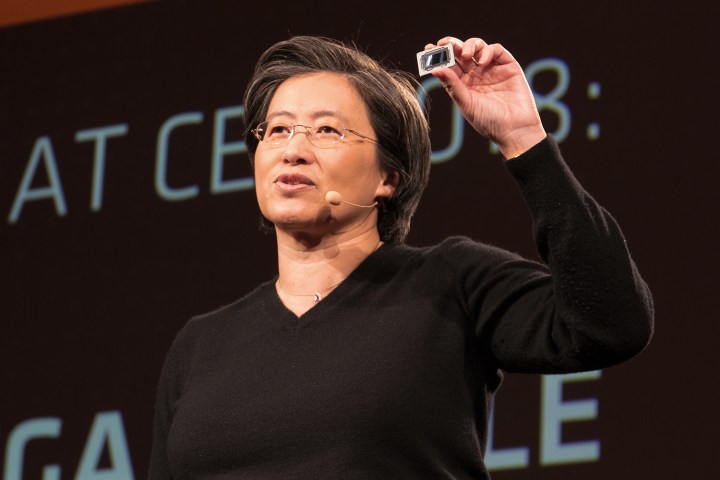
Meanwhile, if you buy any modern smartphone or tablet, you’ll end up with a device that’s fantastic not just for communication — but also entertainment. Today’s mobile gear can play games beautifully, with crisp graphics and surprisingly long battery life. The release of Civilization VI for the iPad Pro proved the point. With a starting price of $650, the iPad Pro isn’t unaffordable, and you’re gonna have a bad time if you try the game on a similarly priced laptop. It’s easier and less expensive to play Civilization VI on iPad Pro than on a laptop — and that sucks.
CES, however, gives us reason to hope that’ll change. AMD and Intel have announced new chips that bring capable gaming performance to lower price points with less power draw. These new chips just might make capable laptop graphics the rule rather the exception.
AMD and Intel team up for new solutions
AMD deserves most of the credit for this new wave of affordable notebook graphics. It built mobile APUs — its term for a chip that pairs a CPU with a GPU — for years, but saw no success because its CPU technology was outdated. Now, though, AMD has a successful CPU in Ryzen and an equally attractive GPU in Vega. Pair them on a chip — and ta-da! You’ve a recipe for budget gaming bliss.
Ryzen mobile first arrived last year, but only in a beefy, top-tier trim that appeared in only a small number of notebooks like the HP Envy x360. CES 2018 adds Ryzen 3 mobile chips to the mix. Though not nearly as quick as the models already released, they will bring Vega-based graphics to systems sold below $500. You’ll see a number laptop designs featuring these chips appear in the first half of 2018 from Acer, Asus, Dell, Lenovo, and HP. A few will be new, but many will be refreshes that add an AMD alternative to a previously Intel-dominated line-up.

Intel is also an important part of this story, thanks to the company’s unusual courtship of AMD. At CES 2018, it introduced four new chips that combine an Intel Core processor with Radeon RX Vega graphics.
They’re not cut-rate versions, either. According to Intel, the most powerful versions should be stiff competition for Nvidia’s GTX 1060 Max-Q. That means almost all games will be playable at 1080p resolution and high or maximum detail. Of course, a chip that capable isn’t likely to appear in affordable laptops, but it will appear in thin laptops and 2-in-1s that previously had to settle for Intel integrated graphics. The leap from Intel UHD 620 to Vega is sure to deliver a huge boost in game performance.
Nvidia, still in the mix
While AMD and Intel came out swinging at CES 2018 with big, early announcements, Nvidia shouldn’t be forgotten. On the contrary, it’s also in the mix, thanks to the humble GeForce MX150.
Nvidia’s most affordable mobile GPU didn’t see much fanfare at its launch. The company didn’t even bestow it the “GT” brand label, nevermind the “GTX” prefix that denotes a serious gaming GPU. Yet the MX150 has impressed, significantly improving on the old 940MX and, as a result, raising the bar on budget gaming overall. The MX150 can smoothly play games like Overwatch and Star Wars Battlefront II at 1080p and medium detail, and you can find it in the Acer Aspire E15 at just $600.

The MX150 popped up in more laptops at CES 2018. Acer stuffed it in the Switch 7 Black Edition to create a thin 2-in-1 with surprisingly excellent graphics performance, Samsung put it in a new Notebook 9 , and Lenovo has placed it in a variety of laptops including the ThinkPad T480s. These are all examples of serious, professional laptops that also lets you load up a round of PUBG when you need a break.
We should note, too, that Nvidia’s core graphics architecture is near due for a refresh. The MX150 actually represents the tail-end of Nvidia’s current hardware (not an exciting fresh chip), and that bodes well for what we’ll see in late 2018.
Finally, laptop gaming for everyone
The laptops that debuted at CES are just the beginning of the wave. Affordable notebooks with powerful graphics remain the exception to the rule even now, at CES 2018. However, there’s finally a broad foundation of affordable, efficient GPUs that system builders can use to change that.
Once people figure out it’s possible to buy a budget laptop that doesn’t completely suck for gaming, they’ll flock to what’s good, and put the bad ole’ days of sucktastic notebook graphics to an end.



